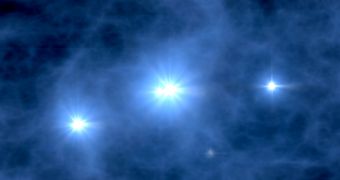New studies in astrophysics bring an unexpected result. Stars with high metalicity have fewer stellar companions. The research was conducted at the Australian National University and the University of New South Wales and could help in the search for stars that have Earth-like planets.
The metalicity is a scientific term that describes the proportion of chemical elements of which a cosmic body is made of, other than hydrogen and helium. In astrophysics terminology, the word 'metal' is usually associated with heavier elements than hydrogen and helium, since on the grand scale of the universe these two elements compose most of the matter that exists.
With the help of the metalicity of an object scientists can estimate its age. A few seconds after the Big Bang, all the matter in the visible Universe was composed of only molecular hydrogen, so the first stars that spawned, also known as Population III had virtually no metalicity. These were incredibly massive stars that during their lives through the process of nuclear fusion created heavier elements, such as helium up to iron. Up until this day no Population III star has ever been observed.
The following stars, belonging to Population II, that received metal-rich dust from the previous population of stars have relatively low metalicity and converted part of the metals to create the heaviest element in the periodic system. Stars like our Sun, some of the youngest in the Universe, are part of the Population I stars and have the highest metalicity.
About ten years ago scientists found that stars, such as the Sun, which contain large amounts of heavy elements have a better chance of being orbited by planets, or to be part of a binary system and be orbited by another star.
Even so, the Sun contains very low levels of heavy elements, about one percent of its entire mass, while many stars could have as little as one third of a percent of their mass in heavy elements and others that can have ten times more than that. Studies show that the metalicity of a star also affects the type of objects that may form around it.
However Dr Lineweaver and Dr Daniel Grether from the University of New South Wales discovered that the opposite of what was generally believed was actually happening. Stars with high contents of metals were less likely to have star companions. So far these results have no theoretical backup to explain why this is happening, but they believe that stars that form in different regions of the galaxy probably followed a different path to stardom.
In our galaxy metalicity is higher at the galactic center and decreases as one moves outwards. This is mainly because of the high density of stars, packed in a relatively small space.

 14 DAY TRIAL //
14 DAY TRIAL //